KB Home Bundle
How did KB Home reshape the American Dream?
KB Home, a titan in the homebuilding industry, boasts a rich history of innovation and adaptation. From its humble beginnings in Detroit, Michigan, to its current nationwide presence, the KB Home SWOT Analysis reveals a compelling story of strategic evolution. Discover how this home builder has consistently responded to market demands and customer preferences.
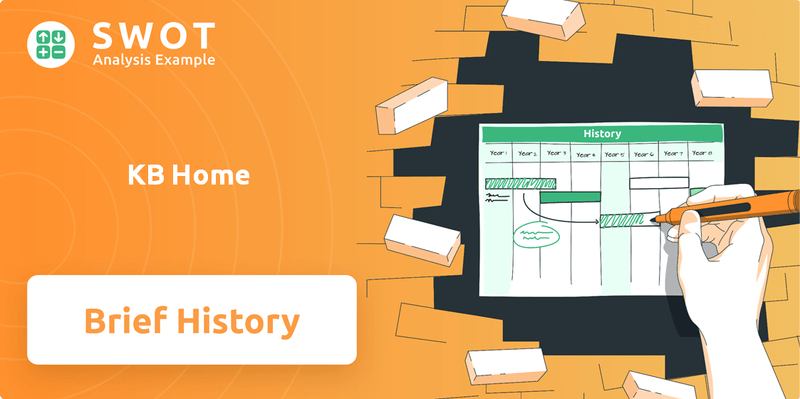
This brief history of KB Home will explore the company's journey from its founding by Donald Bruce Kaufman and Eli Broad, originally named Kaufman & Broad, to its present-day status as a major player in the real estate and housing market. We'll delve into the company's early years, key milestones, and construction methods, highlighting how KB Home has navigated the complexities of the housing market and achieved significant growth over time. Understanding KB Home's company background provides valuable insights for anyone interested in the homebuilding sector and its impact on the American landscape.
What is the KB Home Founding Story?
The story of KB Home, a prominent home builder, began in 1957. Founded in Detroit, Michigan, by Donald Bruce Kaufman and Eli Broad, the company initially operated under the name Kaufman & Broad Building Company. This marked the start of what would become a significant player in the real estate and housing market.
Their initial capital was a $25,000 loan from Eli Broad's in-laws. The founders saw an opportunity in the post-World War II era. They aimed to provide affordable, well-designed homes for a new generation of first-time homebuyers. This early focus on affordability and meeting market demand was key to their initial success.
The company's innovative approach included streamlining construction. They eliminated basements and offered carports instead. This allowed them to price their first homes, called 'Award Winner,' at $13,700. This made the monthly mortgage less than the rent for a two-bedroom apartment, making homeownership accessible to more people.
KB Home's early years were marked by rapid growth and innovative strategies. The company quickly established itself in the Detroit suburbs, selling homes at a pace that demonstrated strong market demand.
- In the first weekend, they sold seventeen homes.
- Within two years, they built 600 homes in the Detroit suburbs.
- By 1959, they expanded into contract housing, developing elderly housing and homes for the armed forces.
- This early success set the stage for future expansion and growth. For more information about the company's owners and shareholders, you can read Owners & Shareholders of KB Home.
KB Home SWOT Analysis
- Complete SWOT Breakdown
- Fully Customizable
- Editable in Excel & Word
- Professional Formatting
- Investor-Ready Format
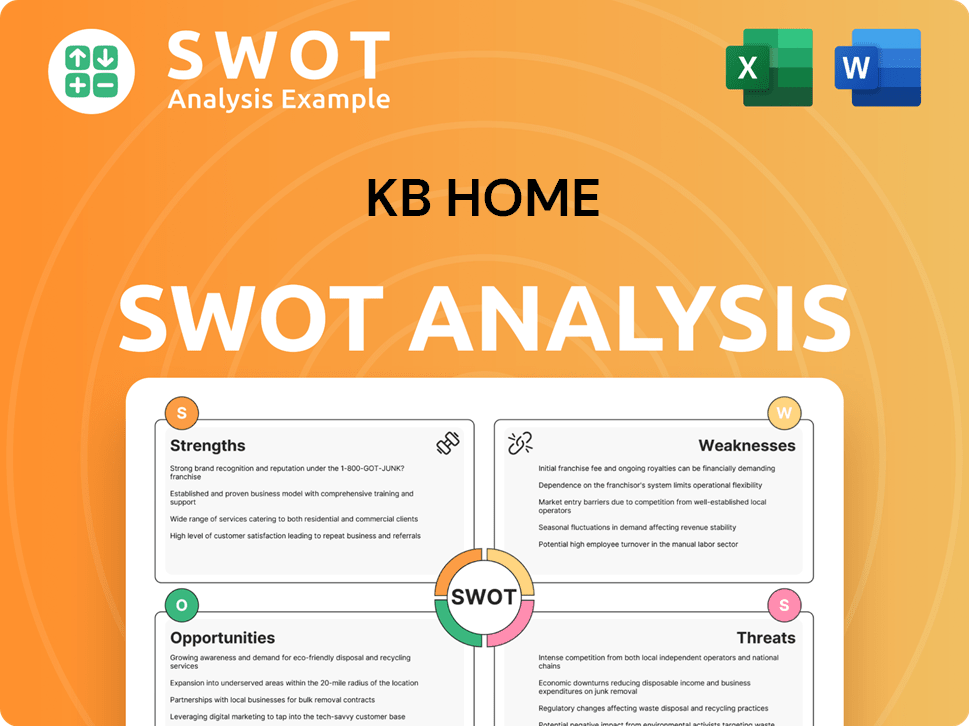
What Drove the Early Growth of KB Home?
The early years of the company, now known as KB Home, were marked by rapid expansion and strategic decisions. The company quickly grew its operations, expanding its reach and diversifying its business interests. These early moves set the stage for its future growth in the housing market.
Shortly after its founding, the company experienced significant growth. In 1959, sales tripled to $5.1 million, with net income reaching 7% of sales. To avoid over-reliance on the automotive industry in Detroit, the company strategically relocated to Phoenix, Arizona, in 1960. This move was a key decision in its early growth, allowing it to tap into new markets and opportunities.
A significant milestone occurred in 1961 when the company went public, raising approximately $1.8 million in its initial public offering. Expansion continued into California in 1963, and by 1967, through the acquisition of Kay Homes, the company became the largest home producer in the San Francisco Bay area. These moves helped establish it as a major player in the home builder industry.
The company was a pioneer in international expansion, entering France in 1967 and introducing model homes in Paris by 1969. In 1965, it founded the International Mortgage Company, and in 1966, it ventured into cable TV franchising with Nation Wide Cablevision. By 1969, the company became the first housing builder listed on the New York Stock Exchange.
The company continued its geographic expansion, opening offices in Arizona, Nevada, and Colorado by 1993, and Utah the following year. Strategic acquisitions further fueled growth, including Opnel Jenkins (New Mexico) in 1995, Rayco Homes (San Antonio) in 1996, Estes Homes (Tucson, Arizona) in 1998, and Colony Homes (Upland, California) in 2003. In 1999, it acquired Lewis Homes for $544 million, and in 2001, it expanded into Florida with the purchase of Trademark Home Builders. In 2001, the company officially shortened its name to KB Home.
KB Home PESTLE Analysis
- Covers All 6 PESTLE Categories
- No Research Needed – Save Hours of Work
- Built by Experts, Trusted by Consultants
- Instant Download, Ready to Use
- 100% Editable, Fully Customizable
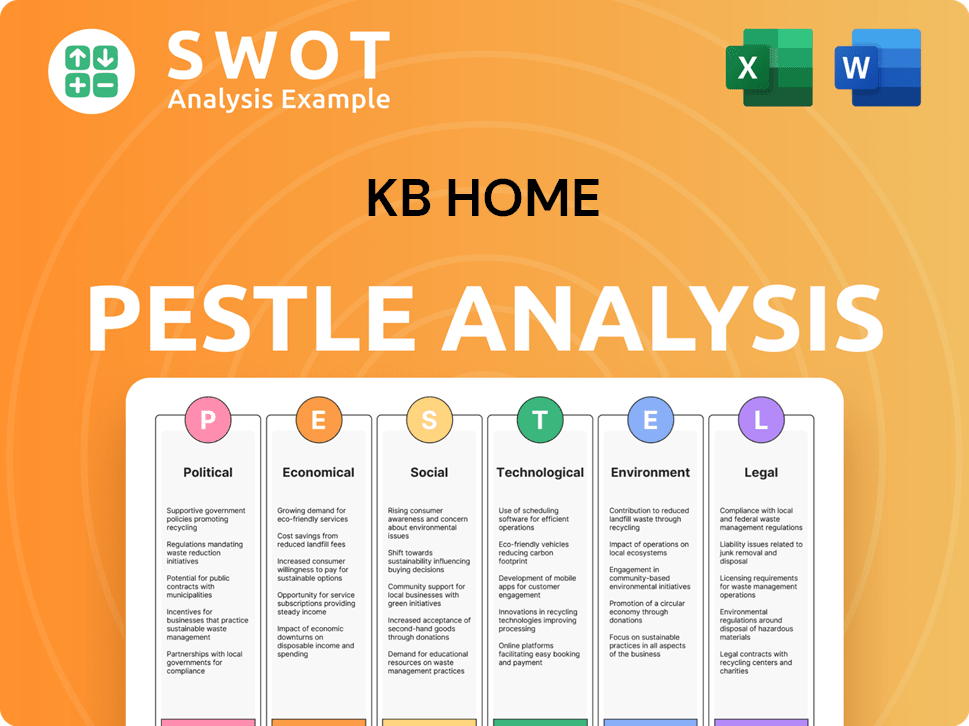
What are the key Milestones in KB Home history?
The story of KB Home, a prominent home builder, is marked by significant milestones that reflect its growth and adaptation in the real estate and housing market. From its early days to its current standing, KB Home's history showcases a commitment to innovation and sustainability.
| Year | Milestone |
|---|---|
| 1967 | Introduced the industry's first five-year limited home warranty. |
| 2007 | Released its first sustainability report, marking an early commitment to environmental responsibility. |
| 2008 | Became the first national builder to make ENERGY STAR® a standard feature in all homes. |
| 2010 | Introduced the Energy Performance Guide® and was ranked #1 Overall Green Builder by Calvert Investments. |
| 2011 | Partnered with SunPower to introduce communities with solar as a standard feature and unveiled the ZeroHouse 2.0. |
| 2024 | Built its 200,000th ENERGY STAR® certified home and achieved an average Home Energy Rating System (HERS) Index score of 45. |
| 2024 | Built over 26,000 WaterSense® labeled and Water Smart homes. |
| 2025 | Introduced the nation's first IBHS-designated wildfire-resilient neighborhood in Escondido, California. |
KB Home has consistently pursued innovation, particularly in energy efficiency and sustainable building practices. These efforts include integrating solar power, developing net-zero energy homes, and setting new standards for water conservation.
KB Home was the first national builder to make ENERGY STAR® a standard feature across all homes in 2008. By 2024, they had built over 200,000 ENERGY STAR® certified homes.
In 2024, KB Home built over 26,000 WaterSense® labeled and Water Smart homes. This initiative has conserved an estimated 2.1 billion gallons of water annually.
In 2025, KB Home introduced the nation's first IBHS-designated wildfire-resilient neighborhood in Escondido, California. This demonstrates a proactive approach to addressing contemporary housing challenges.
KB Home homes built in 2024 have an average Home Energy Rating System (HERS) Index score of 45. This means a 2024 KB home is 55% more energy efficient than a typical home built in 2006.
KB Home partnered with SunPower to introduce communities with solar as a standard feature in 2011. This initiative showcases the company's commitment to renewable energy.
KB Home unveiled the ZeroHouse 2.0 in 2011, aiming for net-zero energy usage. This project highlights their dedication to sustainable building practices.
KB Home has faced challenges such as market downturns and economic uncertainties, which have impacted its financial performance. Despite these hurdles, the company has demonstrated resilience and adaptability, as evidenced by its continued innovation and financial stability.
The company experienced a significant decrease in revenue during the 2008 financial crisis. This period tested the company's ability to navigate economic challenges.
KB Home reported total revenues of approximately $6.44 billion for the fiscal year 2024. This demonstrates the company's financial resilience.
KB Home has adapted to changing market conditions by focusing on energy-efficient homes and sustainable building practices. This has helped them stay competitive.
Since 2000, KB Home customers have saved an estimated $1.3 billion on utility bills. This reflects the company's commitment to providing value.
KB Home has expanded its operations across various regions, adapting its home designs to meet local needs. This helps them to reach a wider audience.
KB Home faces competition from other major home builders in the industry. To thrive, they must continue to innovate and offer value to customers.
KB Home Business Model Canvas
- Complete 9-Block Business Model Canvas
- Effortlessly Communicate Your Business Strategy
- Investor-Ready BMC Format
- 100% Editable and Customizable
- Clear and Structured Layout
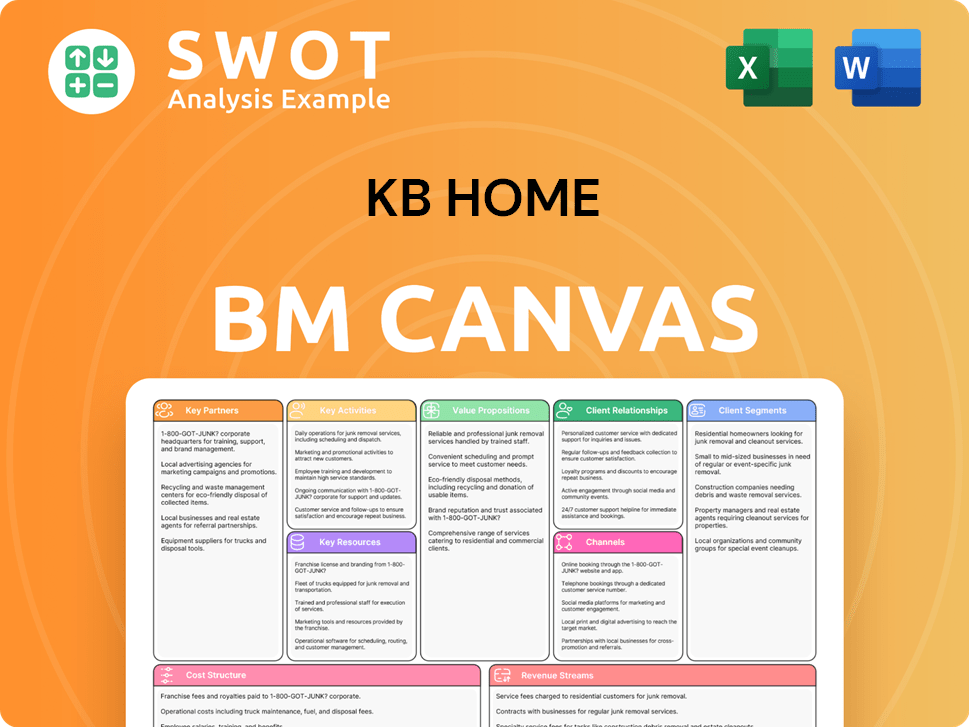
What is the Timeline of Key Events for KB Home?
The KB Home company, a prominent home builder, has a rich history marked by innovation and expansion. From its inception in 1957 as Kaufman & Broad in Detroit, Michigan, the company has evolved significantly. It went public in 1961, expanded into California in 1963, and became the first U.S. homebuilder to enter France in 1967. KB Home has consistently introduced industry firsts, including a five-year home warranty in 1967 and being listed on the New York Stock Exchange in 1969. Over the years, it has rebranded, shortened its name, and focused on sustainability, becoming the first national builder to standardize ENERGY STAR® homes in 2008. Recent milestones include introducing the KB Home Office in 2020 and pioneering all-electric, solar- and battery-powered microgrid communities in 2022. In 2024, KB Home celebrated building its 200,000th ENERGY STAR® certified home and achieving an average HERS Index score of 45, further solidifying its commitment to energy efficiency. In 2025, KB Home is set to introduce the first IBHS-designated wildfire-resilient neighborhood in the nation, reflecting its commitment to innovation and resilience.
| Year | Key Event |
|---|---|
| 1957 | Founded as Kaufman & Broad in Detroit, Michigan. |
| 1961 | Company goes public, raising approximately $1.8 million. |
| 1967 | Introduces the industry's first five-year limited home warranty. |
| 1969 | Becomes the first housing builder to be listed on the New York Stock Exchange. |
| 1995 | Rebrands as KB Home. |
| 2008 | Becomes the first national builder to make ENERGY STAR® a standard across all homes. |
| 2022 | Becomes the first national builder to adopt the EPA's highest water-efficiency standards in drought-prone regions and pioneers two all-electric, solar- and battery-powered microgrid communities. |
| 2024 | Builds its 200,000th ENERGY STAR® certified home and achieves an average HERS Index score of 45. |
| 2025 | Introduces the first IBHS-designated wildfire-resilient neighborhood in the nation. |
KB Home plans to increase its land acquisition and development investment in 2025 compared to 2024 to support future growth. They are focused on capital efficiency and balancing development with their starts pace. This strategic move aims to capitalize on opportunities within the housing market and expand their footprint.
For fiscal year 2025, KB Home anticipates housing revenues to be in the range of $6.60 billion to $7.00 billion. The average selling price is projected to be between $480,000 and $495,000. The company aims for a homebuilding operating income margin of approximately 9.4% for the full year 2025.
KB Home's strategic initiatives for 2025 include expanding scale, profitability, and returns. The company will continue to focus on its built-to-order model, which allows for personalization, and its commitment to energy-efficient and sustainable building practices. They are adapting to economic uncertainties, including interest rate fluctuations.
KB Home intends to continue returning capital to stockholders. In 2024, they returned over $420 million through repurchases and dividends. This commitment to returning capital reflects their confidence in the company's financial health and future prospects within the real estate and housing market.
KB Home Porter's Five Forces Analysis
- Covers All 5 Competitive Forces in Detail
- Structured for Consultants, Students, and Founders
- 100% Editable in Microsoft Word & Excel
- Instant Digital Download – Use Immediately
- Compatible with Mac & PC – Fully Unlocked
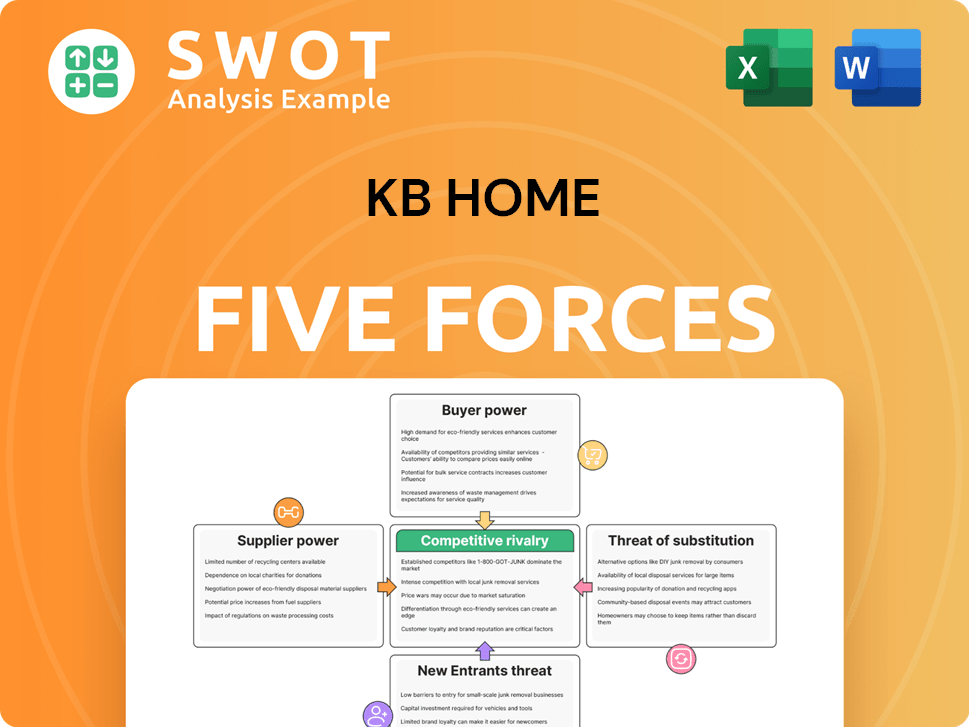
Related Blogs
- What is Competitive Landscape of KB Home Company?
- What is Growth Strategy and Future Prospects of KB Home Company?
- How Does KB Home Company Work?
- What is Sales and Marketing Strategy of KB Home Company?
- What is Brief History of KB Home Company?
- Who Owns KB Home Company?
- What is Customer Demographics and Target Market of KB Home Company?
Disclaimer
All information, articles, and product details provided on this website are for general informational and educational purposes only. We do not claim any ownership over, nor do we intend to infringe upon, any trademarks, copyrights, logos, brand names, or other intellectual property mentioned or depicted on this site. Such intellectual property remains the property of its respective owners, and any references here are made solely for identification or informational purposes, without implying any affiliation, endorsement, or partnership.
We make no representations or warranties, express or implied, regarding the accuracy, completeness, or suitability of any content or products presented. Nothing on this website should be construed as legal, tax, investment, financial, medical, or other professional advice. In addition, no part of this site—including articles or product references—constitutes a solicitation, recommendation, endorsement, advertisement, or offer to buy or sell any securities, franchises, or other financial instruments, particularly in jurisdictions where such activity would be unlawful.
All content is of a general nature and may not address the specific circumstances of any individual or entity. It is not a substitute for professional advice or services. Any actions you take based on the information provided here are strictly at your own risk. You accept full responsibility for any decisions or outcomes arising from your use of this website and agree to release us from any liability in connection with your use of, or reliance upon, the content or products found herein.